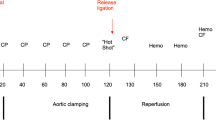Summary
To study the influence of non-coronary collateral blood circulation (NCCBC) on the integrity of the ischemic myocardium a right-sided thoracotomy was performed on 15 anesthetized dogs. Following a total cardiopulmonary bypass (CPB), ventricular fibrillation was induced, during which 2,000 ml calcium-free cardioplegic solution LK 352 was given at the aortic root over an 8–10-min period. Precautions were taken to prevent retrograde blood flow into the coronary system via the coronary sinus. After 90 min of ischemia, ten of the dog hearts were reperfused with systemic blood for the next 30 min. Transmural biopsies were taken from the apex of the left ventricle at the following intervals: (1) before CPB, (2) immediately after the infusion of LK 352, (3) following 90 min of ischemia, (4) after 5 min, (5) after 15 min, and finally (6) after 30 min of reperfusion and were then studied ultrastructurally. The presence of NCCBC was documented by the observation of erythrocyte-filled blood vessels in the biopsies corresponding to nos. 2 and 3 of the above.
To assess the degree of ischemic injury and the extent of myocardial recovery during reperfusion, a scoring system based on a semiquantitative assessment of the characteristic morphological changes was used. The average result of the separately assessed subendo- and subepicardial layers represented thescore, which was plotted on theischemic injury and therecovery scale, thus making a direct comparison of the hearts possible.
All the hearts generously supplied with blood via extracoronary routes during ischemia showed minimal and reversible ischemic injuries. They recovered more quickly and more completely following reperfusion than those hearts without NCCBC. From these results we conclude that despite its warming-up effect on the myocardium and its tendency to wash out the cardioplegic solution, the NCCBC generally protects the myocardium from serious ischemic injuries and shortens the period of recuperation during the reperfusion.
Similar content being viewed by others
References
Anyanwu E (1982) Pathomorphologie des Myokards nach kardioplegischem Herzstillstand. Habilitationsschrift zur Erlangung der Venia legendi für das Fachgebiet Chirurgie, Medizinische Fakultät der Universität Münster
Bloor CM, Liebow AA (1965) Coronary collateral circulation. Am J Cardiol 16:238–252
Borst HG, Iversen S (1980) Myocardial temperature in clinical cardioplegia. Thorac Cardiovasc Surg 28:29–33
Brazier J, Hottenrott C, Buckberg G (1975) Non-coronary collateral myocardial blood flow. Ann Thorac Surg 19:426–435
Bretschneider HJ (1980) Myocardial protection. Thorac Cardiovasc Surg 28:295–302
Buckberg GD (1979) A proposed “solution” to the cardioplegic controversy. J Thorac Cardiovasc Surg 77:803–815
Chiu RCJ, Blundell PE, Scott HJ, Cain S (1979) The importance of monitoring myocardial temperature during hypothermic myocardial protection. Ann Thorac Surg 28:317–322
Hetzer R, Warnecke H Wittrock H, Engel HJ, Borst HG (1980) Extracoronary collateral myocardial blood flow during cardioplegic arrest. Thorac Cardiovasc Surg 28:191–196
Hudson CL, Moritz AR, Wearn JT (1932) The extracardiac anastomoses of the coronary arteries. J Exp Med 56:919–925
Kline JL, Stern H, Bloomer WE, Liebow AA (1956) The application of an induced bronchial collateral circulation to the coronary arteries by cardiopulmonopexy. Am J Pathol 32:663–693
Linzbach AJ (1950) Die Muskelfaserkonstante und das Wachstumsgesetz der menschlichen Herzkammern. Virchows Arch [Pathol Anat] 318:575–618
Schaper J, Hehrlein F, Schlepper M, Thiedemann KU (1977) Ultrastructural alterations during ischemia and reperfusion in human hearts during cardiac surgery. J Mol Cell Cardiol 9:175–189
Schaper J, Mulch J, Winkler B, Schaper W (1979) Ultrastructural, functional and biochemical criteria for the estimation of reversibility of ischemic injury: A study of the effects of global ischemia on the isolated dog heart. J Mol Cell Cardiol 11:521–541
Whalen DA, Hamilton DG, Ganote CE, Jennings RB (1974) Effect of a transient period of ischemia on myocardial cells. I. Effects on cell volume regulation. Am J Pathol 74:318–397
Author information
Authors and Affiliations
Additional information
Supported by funds from the Deutsche Forschungsgemeinschaft, Sonderforschungsbereich 104
Rights and permissions
About this article
Cite this article
Anyanwu, E., Konermann, C., Klinke, F. et al. The influence of non-coronary collateral blood supply on the electively arrested heart during ischemia and reperfusion. Res. Exp. Med. 182, 111–126 (1983). https://doi.org/10.1007/BF01851117
Received:
Accepted:
Issue Date:
DOI: https://doi.org/10.1007/BF01851117




